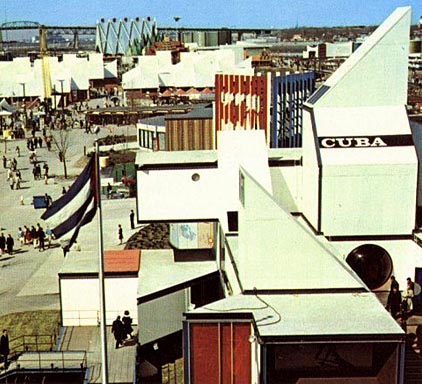Cuba Pavilion
Cuba's pavilion consisted of a series of geometrical white wooden cubes, bordered by marine-blue steel frames. While the tumbled juxtaposition reminded visitors of Mondrian's geometric canvases, the architect said that his design evolved from a series of containers, standardized units that were an offshoot of Cuban experiments in prefabricated housing. Inside, the controversial pavilion presented a theme of "revolution." It was frankly a propagandistic presentation that used black and white photographs to achieve maximum impact. There were huge images of war, revolution, oppressors and leaders in black and white. Human figures in pre-Castro Cuba were white on black (printed like a negative), shown as mere wraiths. Pavilion hostesses explained the symbolism: the people formerly exploited and enslaved, have taken their destiny into their own hands. The interior's paranoid atmosphere was heightened by fishbowl windows in jewel-like tones of red, blue and yellow, which distorted the color of the outside world.
| Cuba's pavilion resembled a Cubist painting, but was really an experiment in simple inexpensive construction. |
The Cubans presented their history, from the discovery of the island by Columbus in 1492, until the takeover by Castro, as one of oppression and exploitation. History was explained in a melange of headlines, symbols and photographs of slaves, missiles. leaders, workers, battles and dictators.
A second floor photo exhibit described the accomplishments of the revolution in education and culture. On the top floor was a wordless film culled from newspaper footage. Cuba as the playground of the rich under Batista was contrasted with the post-revolutionary country in which woman and Negroes, previously discriminated against, played an active role in the building of a socialist society.
